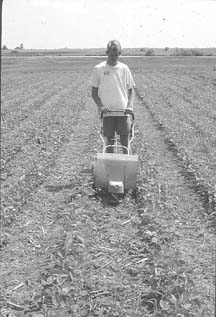
"Whacking weeds" between corn and soybean rows with a field-size string trimmer may be a cost-effective way to reduce herbicide use and eliminate cultivation, according to a USDA researcher who's been testing the idea.
"In no-till, we've been using the string trimmer instead of follow-up herbicide applications. In conventional tillage, we use the string trimmer instead of cultivation," says Bill Donald, at the University of Missouri-Columbia. He's been researching the idea for four years. "Yields have remained comparable to our weed-free checks and we believe this method can significantly reduce potential chemical and sediment runoff into streams, wetlands and wells."
On test plots, a push-type DR trimmer is used twice in both corn and soybeans planted in 30-in. rows.
The first mowing comes after banding herbicides when the crop is about four weeks old and weeds are 3 to 6 in. tall. Weeds are mowed down to within 1 in. of the ground. That's 99 percent effective in killing such problem broadleaves as giant ragweed, lambsquarter and smartweed, but is less effective on grasses such as foxtail, Donald notes.
So a second mowing is done just be-fore the canopy closes to get the second flush of grasses, he says.
Banding herbicides instead of broad-casting and using the string trimmer/mower has reduced herbicide application by as much as 60 percent and mowing has eliminated the need for cultivation, Donald says.
Donald is currently having a four-row string trimmer custom-built. It will use a wire line or flexible chain instead of nylon line to improve performance, he says.
